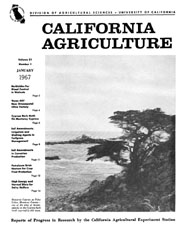|
|||
|
|||

Monterey Cypress at Point Lobos, Monterey County - one of the sites of investigations on the Cypress bark moth reported in this issue.
January 1967
Volume 21, Number 1 |
|||
|
University of California, 1301 S. 46th St., Bldg. 478 Richmond, CA
|